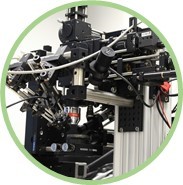
LIBELUL : LIBS for high-throughput elemental analysis
Responsible: Christophe Dujardin, ILM/Université Lyon 1
Keywords: High throughput, analysis, LIBS, Raman, Photoluminescence

The accelerated development of materials through the use of artificial intelligence as proposed in the PEPR DIADEM project requires the development of high-throughput analysis tools in order to feed the databases used. In this context, the elementary analysis can be carried out using LIBS (Laser Induced Breakdown Sprectroscopy) technology, the principle of which consists of analyzing the fluorescence emission spectrum of the plasma induced by the ablation of the material to be analyzed by a laser pulse.
This technique thus makes it possible to detect the different constituents of very diverse materials (metals, insulators, polymers, etc.) with a very good level of sensitivity which can go down to a few ppm for certain elements and is entirely suited to the strategy of the DIADEM project. .
The LIBELUL project aims to develop two “platform” experiences using LIBS technology. The first platform will consist of the implementation of elementary mapping on very large surfaces with a measurement step of 30 µm, requiring targeting very high laser cadence (up to kHz). The imaging will be coupled in a single experiment with RAMAN and Luminescence spectroscopy. Indeed, RAMAN spectroscopy provides information on structural aspects while Luminescence spectroscopy can also provide information on the optical properties of a large number of impurities in their environment as well as certain defects. The use of artificial intelligence will also be exploited for the automatic detection of major elements and the improvement of the signal-to-noise ratio in order to also accelerate the processing of raw data.
If the first platform plans to receive the materials to be analyzed, the second LIBS platform plans on the contrary to go to the high-speed synthesis site of materials. It is therefore a question of developing a mobile and adaptable LIBS platform that can be operated on site. This second platform will present the best performance combining sensitivity and reproducibility and will be intended to be easily operable. These two platforms will enrich the high-throughput elementary analysis tools of the DIADEM project.